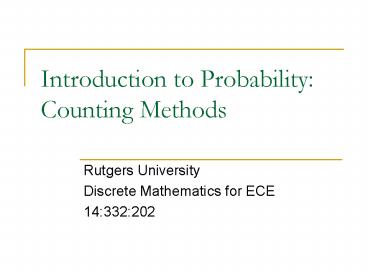Introduction to Probability: Counting Methods - PowerPoint PPT Presentation
1 / 17
Title:
Introduction to Probability: Counting Methods
Description:
Two cards are the same. Sample Space. All Possible Outcomes ... First, we find number of values 13 choices, and choices of suits: ... – PowerPoint PPT presentation
Number of Views:51
Avg rating:3.0/5.0
Title: Introduction to Probability: Counting Methods
1
Introduction to Probability Counting Methods
- Rutgers University
- Discrete Mathematics for ECE
- 14332202
2
Why Probability?
- We can describe processes for which the outcome
is uncertain - By their average behavior
- By the likelihood of particular outcomes
- Allows us to build models for many physical
behaviors - Speech, images, traffic
3
Applications
- Communications
- Speech and Image Processing
- Machine Learning
- Decision Making
- Network Systems
- Artificial Intelligence
- Used in many undergraduate courses (every grad
course)
4
Methods of Counting
- One way of interpreting probability is by the
ratio of favorable to total outcomes - Means we need to be able to count both the
desired and the total outcomes - For illustration, we explore only the most
important applications - Coin flipping
- Dice rolling
- Card Games
5
Combinatorics
- Mathematical tools to help us count
- How many ways can 12 distinct objects be
arranged? - How many different sets of 4 objects be chosen
from a group of 20 objects? - -- Extend this to find probabilities
6
Combinatorics
- Number of ways to arrange n distinct objects
- n!
- Number of ways to obtain an ordered sequence of k
objects from a set of n n!/(n-k)! -- k
permutation - Number of ways to choose k objects out of n
distinguishable objects
This one comes up a lot!
7
Set Theory and Probability
- We use the same ideas from set theory in our
study of probability - Experiment
- Roll a dice
- Outcome any possible observation of an exp.
- Roll a six
- Sample Space the set of all possible outcomes
- 1,2,6
- Event set of outcomes
- Dice rolled is odd
8
Venn Diagrams
- Outcomes are mutually exclusive disjoint
S
2
3
1
5
4
6
Event A
Outcomes
9
An Example from Card Games
- What is the probability of drawing two of the
same card in a row in a shuffled deck of cards? - Experiment
- Pulling two cards from the deck
- Event Space
- All outcomes that describe our event
- Two cards are the same
- Sample Space
- All Possible Outcomes
- All combinations of 2 cards from a deck of 52
10
Sample Space/Event Space
- Venn Diagram
Event Space (set of favorable outcomes)
S
all possible outcomes
A,A
K,2
11
Calculating the Probability
- P(Event)
- Expressed as the ratio of favorable outcomes to
total outcomes - -- Only when all outcomes are EQUALLY LIKELY
12
Probabilities from Combinations
- Rule of Product
- Total number of two card combinations?
- We need to find all the combinations of suit and
value that describe our event set use rule of
product to find the number of combinations - First, we find number of values 13 choices, and
choices of suits to give our number of
possible outcomes ? 136 78 - Probability(Event) 78/1326 0.0588
13
Probabilities from Subexperiments
- Only holds for independent experiments
- Lets look at the last problem
- Two subexperiments
- First can be anything 52/52 1
- Second, must be one of the 3 remaining cards of
the same value from 51 remaining cards ? 3/51
0.588
14
An Example from Dice Rolling
- Experiment Roll Two (6-sided) Dice
- Event Numbers add to 7
- Sample Space (all possible outcomes)S
15
Sample Space/Event Space
Event Space
- Venn Diagram
S
16
Calculating Probability
- P(Event) 6/36 1/6
17
Side Note
- Probability is something we calculate
theoretically as a value between 0 and 1, it is
not something calculated through experimentation
(that is more statistics). - Just because you roll a dice 100 times, and it
came up as a 1 20 times, does not make P(roll a
1) 0.2 - It would be the limiting case in doing an
infinite number of experiments, but this is
impossible. - So, call your calculated values the
probability, and your experimental values the
relative frequency.































